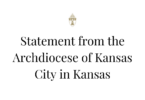All Saints parishioner hikes the way of St. James in Spain
by Joe Bollig
joe.bollig@theleaven.org KANSAS CITY, Kan. — When most Americans want to get away from it all, they go on vacation. But not Steven Kuchero.
Kuchero, a member of All Saints Parish in Kansas City, Kan., didn’t head for the beach, the mountains, or even Disneyland. He followed the well-worn path cut by millions of pilgrims before him for 1,000 years.
He hiked the Way of St. James (of Compostela) — that’s “Camino de Santiago de Compostela” — in northern Spain.
Kuchero ended up on the pilgrim trail because of the recommendation of a priest friend.
“I just wanted some time away,” he said. “I lost my mother [in February], and I wanted to look at my own life.”
Kuchero was in decent shape. He had been a lay Jesuit missionary to Central America in the late 1990s, and had been a triathlete and long-distance bicyclist. So not much preparation was involved.
“I did a little bit of study, but I have to admit, I winged it,” he said. “The way the pilgrimage works, you don’t have to do a lot of planning.”
Since the Way of St. James is such an ancient pilgrimage, a series of hostels or “albergues” has been established for travelers over the years. These simple, spartan accommodations offer a place to sleep, clean up, and cook food, but little else. Kuchero brought a backpack, a sleeping bag, a change of clothes and toiletries.
“You don’t need much, honestly,” he said.
There is no single pilgrimage route. Rather, there are several routes that snake their way across Europe to the Cathedral of Santiago de Compostela, where the remains of St. James, brother of St. John and fellow apostle, are reputed to be entombed.
Kuchero walked the route alone, although he met several other pilgrims — even Americans — along the way. The pilgrimage has been undergoing a renaissance over the past decade or so.
Kuchero began his journey at the port city of Cudillero on July 15 and arrived at Santiago de Compostela on July 27.
“The main thing was I just wanted to go as a pilgrim, to search for inner discovery,” he said. “I prayed a rosary every day.”
On any given day he covered anywhere from 10 to 20 miles, depending on how he felt. Usually by the end of the day, he was really beat.
“What I found amazing was that I’d go to bed that night and then get up in the morning with all this pain and soreness gone,” he said. “I’d start walking and get into the swing of it, and it would be several miles before I felt pain like I did before.”
This well-traveled route follows some highways and roads, but also includes paths over ancient stone bridges past centuries-old churches. There are signs that mark the way, usually with the symbol of a scallop shell (because pilgrims of old used to carry them to scoop drinking water from the streams they passed).
Even though Kuchero hiked without a companion, he was never really alone, because there were so many other people. Often he’d run into the same ones time and again, and a kind of pilgrim camaraderie developed. He met a German who had walked all the way from Munich and an Austrian who walked from Vienna.
But not all walking the Way of St. James were pilgrims.
“Many were just doing it because they had some time off and it was an adventure — not a religious thing in any way,” said Kuchero. “I’d say that was half the people. I couldn’t tell you how many were Catholic. It was just not part of the conversation.”
Kuchero ended his pilgrimage by walking beyond Santiago to Finisterra — meaning, in Latin, “end of the earth.” As he sat there on a rock looking west out over the void, he sensed something else nearby.
“And there was a dog sitting there,” said Kuchero. “He was doing the exact same thing, looking out over the ocean. I thought he must have been thinking the same thing I was thinking.”






